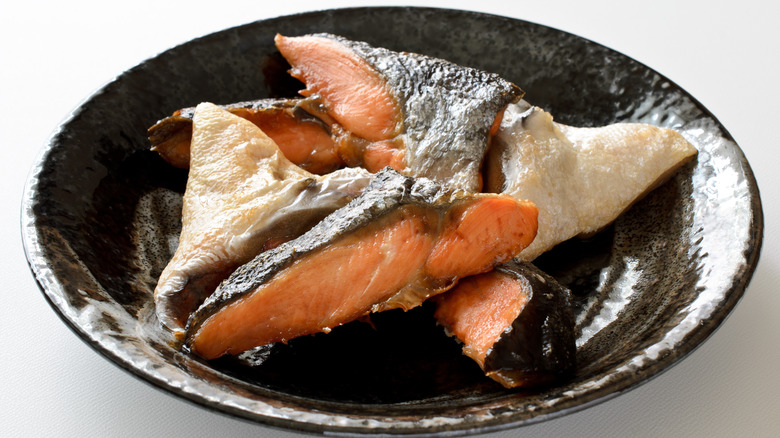Why The Collar Is The Most Underrated Cut Of Fish
If you've ever been to a butcher shop, you're likely familiar with the term off-cuts. According to Bon Appétit, butcher shops are unlike most grocery stores in that they tend to purchase animals whole and break them down into manageable cuts to sell to customers. While grocery stores distance the relationship between product and consumer through plastic packaging, at butcher shops, the evidence of your meat's origin is front and center. Everything is on display, and every scrap of meat is for sale. Where else will you find merlot steak, beef shank, or lamb neck?
The same is true of fish. At the supermarket, there's the usual assortment of salmon, cod, and tuna steaks, which have been cut into filets and displayed on ice, per Cook's Country. And, of course, it's accompanied by a mix of shellfish and maybe a live lobster tank, but usually, that's pretty much it.
This strikes us as a shame because there is far more to fish than filets. A fishmonger, the marine foods equivalent of a butcher, per Dalstrong, is far more likely to have exciting selections of whole, exotic, or trash fish, which are fish that no one thinks to buy. One secret to buying from fishmongers is not just finding the least popular and, therefore, cheapest fish but buying an uncommon cut of a popular one. That's where fish collars, the most underrated cut of fish, come in.
Packed with flavor and hard to dry out
No one wants dry, chalky fish. As universally available as fish filets are, they do run the risk of being overcooked if left on the heat just a little too long. One way to avoid this is by buying fish collars. According to Bon Appétit, a fish's collar — the triangular bit of meat and bone just behind the clavicle — is fatty, tender, and packed with flavor. Typically, you'll be looking for ones from larger fish like salmon.
Fish collars are a bone-in meat, which simply means that the bone is part of the cut. Having the bone as part of the cut of the collar means that the collar is going to be far harder to overcook than a filet (via Epicurious). The collar is a combination of bone, meat, skin, and fat, and a cut with higher fat content has more wiggle room when it comes to cooking time because the fat melts and moistens the meat. Another benefit of fish collars is that, since they are considered an off-cut, purchasing some goes a long way towards more sustainable fish consumption. After all, the more of the fish that's being used, the less that's wasted.

